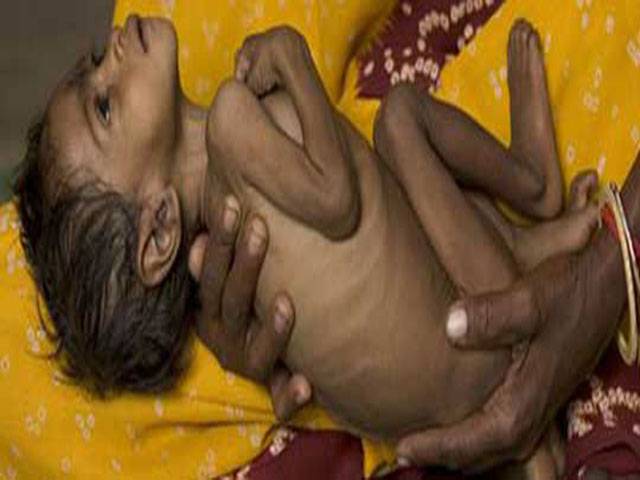THOMAS CHANDY
India’s growing riches have been the subject of many global discussions. In the past few years, India has responded to international emergencies by reaching out with support in cash and kind. However, India has still not managed to get a grip on the problem of malnutrition its children face, a fact that India’s prime minister this year called a “national shame”.
The facts are daunting - as many as nearly half of India’s children below five years are malnourished. Girls are even more malnourished as inadequate resources of families are divided preferentially among men.
India’s nutrition problem shows among women as well - the malnourished girls grow up to be anaemic, deliver underweight babies who face an increased risk of dying and being sick right after their birth. India ranks 76 among 80 middle-income countries rated for the “best place to be a mother” according to the Save the Children’s Mothers’ Index released in May 2012.
‘ANGANWADI’ CENTRES
The problem of malnourishment in India is a reflection on its deeply entrenched poverty and a lack of functionality of its systems. Policymakers from the comfort of their oversized public-funded accommodation while examining the failure of their policies often argue that a country of India’s size - both in terms of geography as well as population - is difficult to administer.
What they admit a little reluctantly is that the government-supported institutions are neither effective nor accountable to the people, and that the budget allocations in sectors critical for people’s well-being are still abysmally low. India’s wealth - no longer so new-found - has so far not filtered down to the areas which would make considerable difference to the lives of its common people.
A question often asked in India is about the co-existence of hunger and malnutrition alongside the problem of plenty - of thousands of tonnes of food grains rotting due to poor storage in government stores while the poor go to bed hungry. Clearly, the problem is not of a lack of resources but of systems that ensure that the country’s opportunities and resources are more equitably and equally divided.
India’s response to its massive problem of malnutrition has been largely through the Integrated Child Development Services, or ICDS as it is known.
The ICDS runs preparatory schools-cum-health institutions called anganwadi centres where pregnant and lactating women and children below five years receive supplementary nutrition while children are also taught to take first steps towards learning letters and numbers. Many states have further equipped their anganwadi centres to enable them to treat the common ailments of children.
Considering the critical role of anganwadi centres in helping children remain healthy, they should have been universalised decades ago but they have not. Anganwadi centres cover only 50 per cent of India’s children.
However, data as well as anecdotal evidence appearing in the form of newspaper reports points out that anganwadi centres do not function at their optimum capacity and efficiency. Their staff are not accountable to the people of the village, and being “influential” (some of them are known to be relatives of village headmen and other important members of the village) are not susceptible to punitive action when they fail to perform their duty.
POVERTY AND
MALNOURISHMENT
That is a typical Indian situation - one can get away without being punished for one’s wrongdoings if one has the right connections. This is the bane of most of India’s institutions and facilities which are meant to serve the people but become, instead, means of employment and influence for a few.
Under the patronage of this protection, doctors in government hospitals may remain absent from work without a note on the attendance register for days, teachers may not teach, clerks in offices may demand a bribe to perform a task which is the right of a citizen.
The impact of dysfunctional systems on the lives of the poor and the marginalised is devastating as they have no alternatives. The poor die of common illnesses if they do not get treated at government hospitals, or they go borrow money to access a private hospital and go into debt.
In fact, the WHO has said that 3.2 per cent Indians would fall below the poverty line because of high medical bills with about 70 per cent of Indians spending their entire income on healthcare and purchasing drugs.
The Planning Commission also accepts that out of pocket expense to pay for healthcare costs is a growing problem in India. It says 39 million Indians are pushed to poverty because of ill health every year.
Around 30 per cent in rural India didn’t go for any treatment for financial constraints in 2004. In urban areas, 20 per cent of ailments were untreated for financial problems the same year, said a recent study in the Lancet.
The government needs to look at health and education as critically important sectors in the development paradigm. If India is to reap its demographic dividend, it cannot do so with half of its children malnourished and not reaching their full potential.
–Aljazeera
Friday, April 19, 2024
India’s malnutrition problem - a systemic issue

8:09 AM | April 19, 2024
Hafiz Naeem takes oath as JI chief, announces anti-government movement
11:39 AM | April 19, 2024
Karachi: AVLC hands over snatched, stolen cars to owners
April 19, 2024
Bid to smuggle Siberian cranes foiled, accused held
April 19, 2024
Tajir Dost app: Traders show lack of interest in registration process
11:09 AM | April 19, 2024
Three abducted people rescued in police operation
April 19, 2024
A Tense Neighbourhood
April 19, 2024
Dubai Underwater
April 19, 2024
X Debate Continues
April 19, 2024
Hepatitis Challenge
April 18, 2024
IMF Predictions
April 18, 2024
Kite tragedy
April 19, 2024
Discipline dilemma
April 19, 2024
Urgent plea
April 19, 2024
Justice denied
April 18, 2024
AI dilemmas unveiled
April 18, 2024
ePaper - Nawaiwaqt
Advertisement
Nawaiwaqt Group | Copyright © 2024





